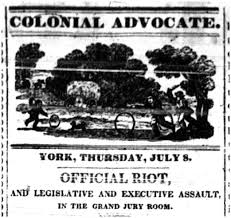Almost 430,000 copies of newspapers were circulated in Upper Canada in 1836 among a population of 370,000, of whom it was claimed perhaps one in 50 could read, according to Anna Brownell Jameson in her celebrated travel book, Winter Studies and Summer Rambles in Canada. Despite their shortcomings, Jameson found the Upper Canada newspapers more beneficial than harmful. Mrs. Jameson was in Upper Canada only nine months, from December 1836 to September 1837, to visit her estranged husband, Attorney General Robert Jameson, possibly a failed attempt at reconciliation. Newspapers still received outside news by slow-travelling mail; in the next decade, news began to travel much faster by telegraph. Jameson’s book was published in London in 1839, with the latest edition published in Toronto in 1965 by McClelland and Stewart, from which the following excerpt is taken.
Apropos to newspapers—my table is covered with them. In the absence or scarcity of books, they are the principal medium of knowledge and communications in Upper Canada. There is no stamp-act here—no duty on paper; and I have sometimes thought that the great number of local newspapers which do not circulate beyond their own little town or district, must, from the vulgar, narrow tone of many of them, do mischief; but on the whole, perhaps, they do more good.
Paragraphs printed from English or American papers, on subjects of general interest, the summary of political events, extracts from books or magazines, are copied from one paper into another, till they have travelled round the country. It is true that a great deal of base, vulgar, inflammatory party feeling is also circulated by the same means; but, on the whole, I should not like to see the number or circulation of the district papers checked. There are about forty published in Upper Canada…
The newspapers of Lower Canada and the United States are circulated in great numbers; and, as they pay postage, it is no inconsiderable item in the revenue of the post-office. In some of these provincial papers I have seen articles written with considerable talent; amongst other things, I have remarked a series of letters signed Evans, addressed to the Canadians on the subject of an education fitted for an agricultural people, and written with infinite good sense and kindly feeling; these have been copied from one paper into another, and circulated widely; no doubt they will do good.
Last year [1836] the number of newspapers circulated through the post-office, and paying postage, was: Provincial papers 178,065; United States and foreign papers 149,502.
Add 100,000 papers stamped or free, here are 427,567 papers circulated yearly among a population of 370,000, of whom, perhaps, one in fifty can read… It is rather affecting to see the long lists of unclaimed letters lying at the post-office, and read the advertisements in the Canada and American journals for husbands, relatives, friends, lost or strayed.
There is a commercial news-room in the city of Toronto, and this is absolutely the only place of assembly or amusement, except the taverns and low drinking-houses.
Unfamiliar Canadian history stories 035
